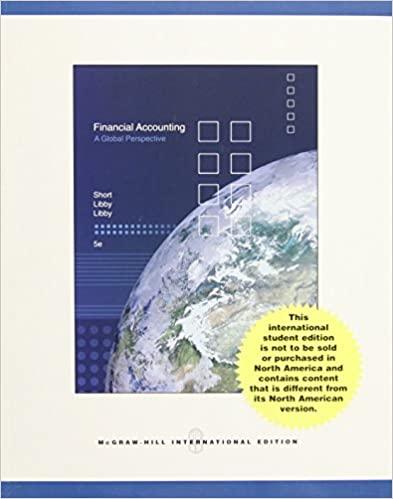Question
At a recent trade show, a Canadian company unveiled its radical new product for the sports equipment industry - a graphite hockey stick! The company,
At a recent trade show, a Canadian company unveiled its radical new product for the sports equipment industry - a graphite hockey stick! The company, known as"He Shoots, He Scores" has enthusiastic plans for the stick. As owner of a medium-sized retail sporting goods store, you are aware of the various costs involved in ordering and holding inventory. Taking into account the respective costs, you are to develop an appropriate ordering policy for this brand-new item.
Since this is a new product, you have no historical data on which to base your forecast of demand. However, you have data on the number of sticks sold for other new, state-of-the-art sticks from prior years:
| 2 years ago | Last year | 2 years ago | Last year | |||
| Jul | 20 | 24 | Jan | 34 | 68 | |
| Aug | 35 | 44 | Feb | 41 | 62 | |
| Sep | 59 | 49 | Mar | 38 | 33 | |
| Oct | 79 | 100 | Apr | 19 | 26 | |
| Nov | 42 | 51 | May | 27 | 26 | |
| Dec | 83 | 81 | Jun | 25 | 21 |
As in any business, sales for any given month could be extremely volatile (or not). In this game, the demand for the next year is generated from a Normal distribution (which ranges from negative infinity to infinity). It is not necessary to know the parameters of the Normal distribution for this game, but they are given at the end of these instructions.
"He Shoots, He Scores" will allow you to purchase hockey sticks for $20. Marketing research results given at the recent trade show indicated that potential customers would pay up to $30 for the item. Thus, you plan to use $30 as your selling price. Note that the amount you sell in a given month is always the lowest of either monthly demand or (beginning inventory + quantity ordered).
Placing an order costs you $60 (note that the manufacturer allows at most one replenishment per month). Any unsatisfied demand (a stockout, or should we call it a "stick" out?) costs you $7 per unit short. Backorders are not allowed (since customers will most likely purchase the hockey stick from a competitor if you don't have enough on-hand). Inventory remaining at the end of a month costs you $1 per unit.
Your task is to plan replenishments (when to order, how much to order) on a month-by-month basis for the next 12 months. Assume that the first month in the planning horizon is July, and that there is no inventory on-hand. After you make your replenishment decision, assume the demand for that month is 30. Then, you may make the decision for next month. Use the attached table to indicate your monthly replenishments, and to tabulate the results of your respective strategy. If a stockout occurs, write "0" for the ending inventory, and put a "0" for the beginning inventory of the subsequent month. Add your explanation based on the problem-solving rubric below the worksheet.
For example, assume that there were no units in beginning inventory, and that you ordered 15 sticks at the beginning of July. Assuming a demand of 23 sticks, you would face the following costs:
revenue: $30 * min(0+15,23) = $30 * 15 = $450
ordering cost: $60 + ($20 * 15) = $360
shortage cost: $7 * 8 = $56
holding cost: 0 (since there is no ending inventory - i.e. we had a stockout)
monthly profit = $450 - ($360 + $56) = $34
Parameters for Normal Distribution:
Normal( (D2+D1*3) / 4 , Absvalue (D1-D2) )
where: D1 is demand last year
D2 is demand 2 years ago
Thus, demand for July is calculated from: Normal ((20+24*3) / 4, Absvalue (24-20))
Normal (23,4)
| Worksheet | ||||||||||||||
| July | Aug | Sept | Oct | Nov | Dec | Jan | Feb | March | April | May | June | |||
| 1 | Beg. Inventory | 0 | ||||||||||||
| 2 | Order quantity | |||||||||||||
| 3 | Number available = (1) + (2) | |||||||||||||
| 4 | Demand | |||||||||||||
| 5 | End. Inventory = max[(3)-(4), 0] | |||||||||||||
| Revenue: | ||||||||||||||
| 6 | Sales = $30 * min [(3), (4)] | |||||||||||||
| Costs: | ||||||||||||||
| 7 | Ordering If (2)>0, = $60 + ($20* (2)), If (2)=0, = 0 | |||||||||||||
| 8 | Shortage = - $7 * min[0, (3)-(4)] | |||||||||||||
| 9 | Holding = $1 * (5) | |||||||||||||
| 10 | Total Costs = (7) + (8) + (9) | |||||||||||||
| 11 | Monthly Profit = (6) - (10) | |||||||||||||
| 12 | Annual Profit | |||||||||||||
Step by Step Solution
There are 3 Steps involved in it
Step: 1

Get Instant Access to Expert-Tailored Solutions
See step-by-step solutions with expert insights and AI powered tools for academic success
Step: 2

Step: 3

Ace Your Homework with AI
Get the answers you need in no time with our AI-driven, step-by-step assistance
Get Started


